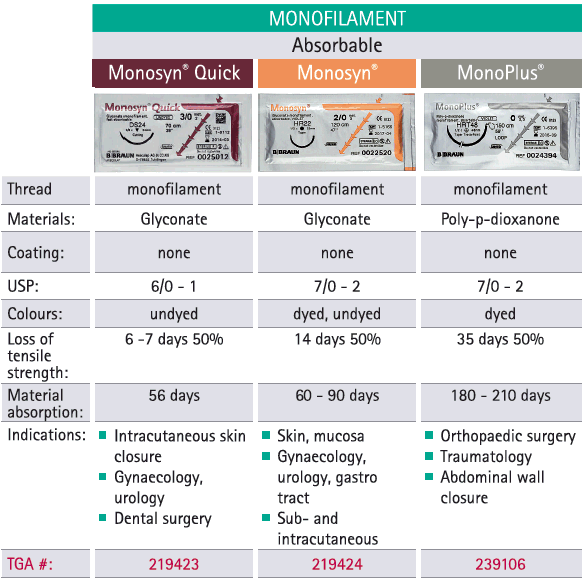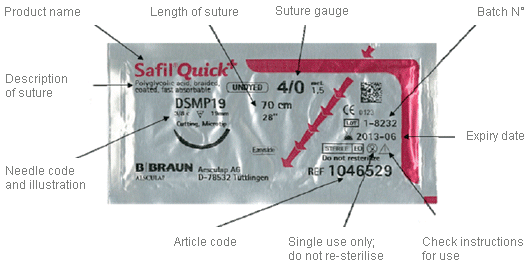Natural, synthetic, braided, twisted, monofilament, Polydioxanone, Glyconate, Polypropylene, absorbable, non-absorbable, pseudo-non absorbable, hydrolysis, enzymatic, taper, reverse cutting, trocar, micropoint, straight, 1/2 circle, 3/8th circle, 5/8th circle…no, you’re not reading a list of website keywords to improve your google search hits (well, maybe you are). My point is, to the untrained individual, understanding sutures well enough to make a confident decision is daunting. Add to this the expectations of the Veterinary Surgeon, the commercial arrangements that may be in place or even how much it will cost the client, one would be forgiven for leaving sutures well and truly alone. However, it doesn’t need to be this way. To make life easier for those seeking the right suture for their requirements, all manufacturers are required to follow some strict international guidelines when labelling and categorising their product.

Colour coding
Suture packaging is required to be colour coded so you are able to match the resorption process (or absence of), with the wound healing process. Here are some examples:
Grey = long term absorbable monofilament;
Salmon / Peach = mid term absorbable monofilament;
Violet = mid term absorbable multifilament;
Pale Green = pseudo-non absorbable monofilament.
Resorption profile
Once you have the colour coding in your mind, consider the wound that you’re planning to close and whether the suture you’ve preselected is really the best choice. A Polydioxanone suture (grey) has an approximate mass-absorption period of 210 days with a 50% tensile strength of approximately 42 days. Does an ovarian pedicle really need a suture, which will be considered by the body as a foreign body, to be in vivo for 1/2 the year? Consider the critical wound holding period first, then once the body is likely to self-approximate, the suture is best gone as quickly as possible.
Needle image
These should be clearly pictured on the outside packaging and suture sachet, allowing you to easily identify the shape, body curvature and the needle point. The needle length should also be identified in mm, eg 26mm.

Thread Diameter
Thread measurements are noted in Metric or USP (stands for United States Pharmacopoeia). International companies tend to include both measurements to satisfy the various local requirements, but what do these measurements mean. Generally, thicker is stronger. There is direct correlation between physical thickness and diameter, but strength is also greatly influenced by the type of material. Steel is considered the strongest material by relative diameter and Catgut is the weakest.
Registered or un-registered
Australia has very fairly light regulations in place to manage the importation and sale of wound critical medical devices, such as surgical sutures into the Veterinary market. The APVMA states that “Devices and equipment that are used to assist in veterinary medical or surgical procedures, are chemically inert and act by physical rather than biochemical means, and make no claim other than that arising from their physical action, generally do not require registration”. However, if you discuss the process of how an absorbable suture breaks down within the body, albeit hydrolysis or enzymatic process, both are chemical processes from within a biochemical environment ie. a living body. This light regulation allows products into the veterinary market from blind manufacturing sites where the quality control processes cannot be easily tracked. Australia does however have one of the best regulatory bodies in the world to monitor products into the human market. Products that are registered with the Therapeutic Goods Administration (TGA) have passed rigorous manufacturing and quality tests and these items are readily available in the Veterinary market, you just have to ask for the Australian Registry of Therapeutic Goods (ARTG) registration number.
Written by Peter Darge @BBraun
